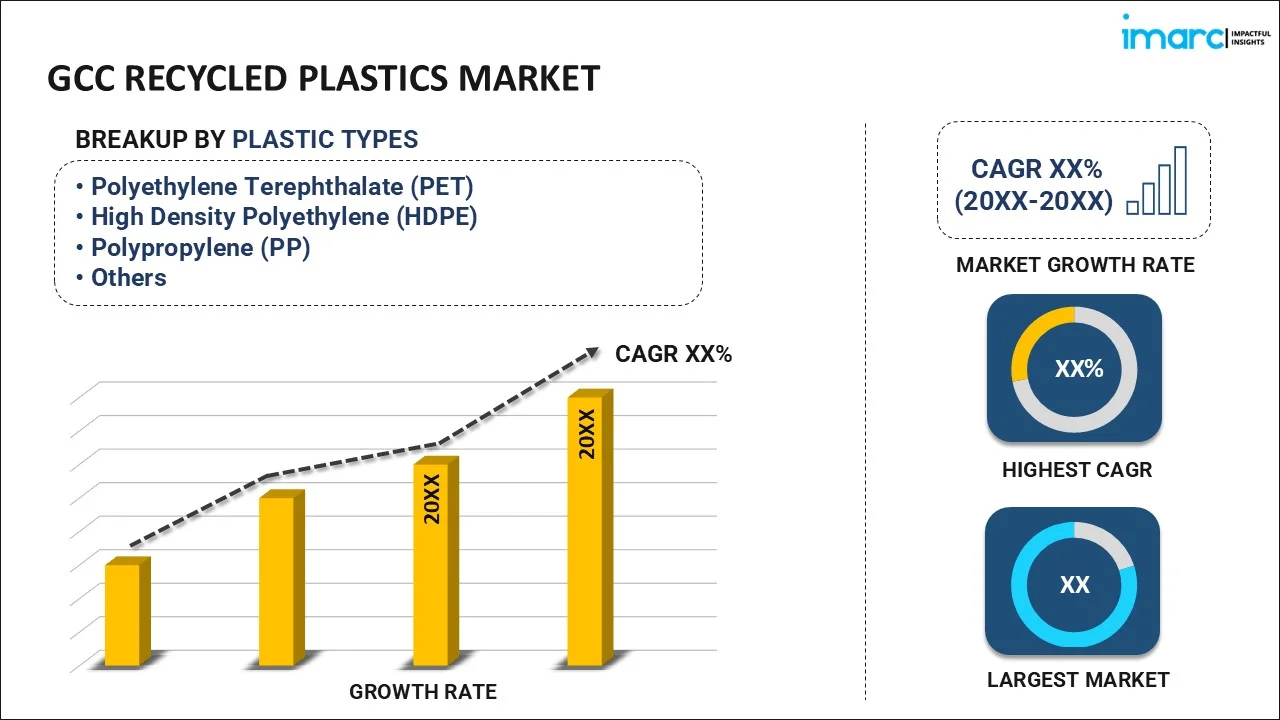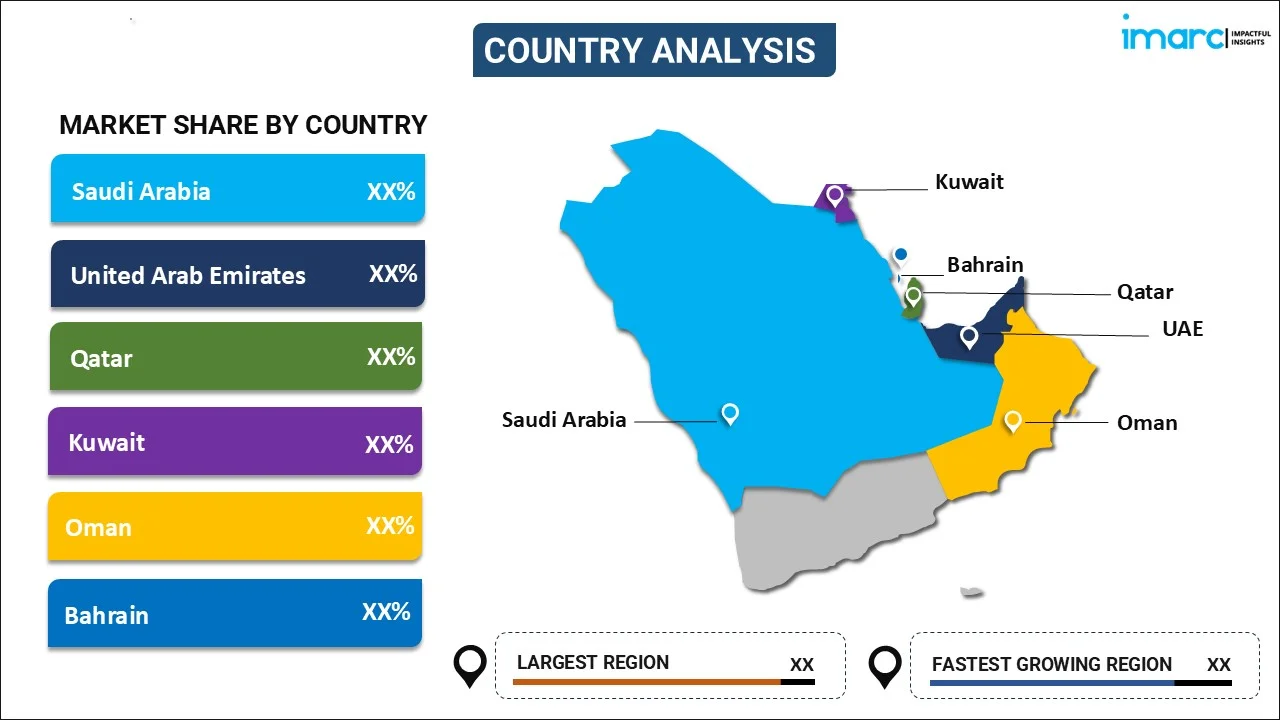
GCC Recycled Plastics Market Report by Plastic Type (Polyethylene Terephthalate (PET), High Density Polyethylene (HDPE), Polypropylene (PP), Low Density Polyethylene (LDPE), and Others), Raw Material (Plastic Bottles, Plastic Films, Rigid Plastic and Foam, Fibers, and Others), Application (Non-Food Contact Packaging, Food Contact Packaging, Construction, Automotive, and Others), and Country 2025-2033
Market Overview:
The GCC recycled plastics market size reached USD 837.6 Million in 2024. Looking forward, IMARC Group expects the market to reach USD 1,591.4 Million by 2033, exhibiting a growth rate (CAGR) of 7.4% during 2025-2033. The rising sustainability concerns, favorable regulatory support, the widespread product application across industries, significant technological innovations, and the rising trend towards circular economy principles represent some of the key factors driving the market.
|
Report Attribute
|
Key Statistics
|
|---|---|
|
Base Year
|
2024 |
|
Forecast Years
|
2025-2033
|
|
Historical Years
|
2019-2024
|
| Market Size in 2024 | USD 837.6 Million |
| Market Forecast in 2033 | USD 1,591.4 Million |
| Market Growth Rate (2025-2033) | 7.4% |
Recycled plastics refer to the collection, cleaning, and processing of used plastic materials to create new products, thereby reducing the amount of virgin plastic required. This practice aligns with environmental sustainability, as it helps conserve natural resources and minimize waste in landfills. Recycled plastics can be sourced from a variety of consumer products, such as bottles, containers, and packaging materials. The characteristics of recycled plastics depend on the type of plastic being processed, and these can vary in strength, flexibility, and appearance. Recycled plastics may be categorized into two main types: post-consumer and post-industrial. Post-consumer recycled plastics are derived from end-user products, while post-industrial recycled plastics come from manufacturing waste. The recycling process generally involves sorting, cleaning, shredding, melting, and remolding, and it may introduce certain changes in the material's properties. Recycled plastics reduces tensile strength and are less resistant to impact. Features such as the potential for customization and cost-efficiency make recycled plastics an appealing option for various industries, including construction, automotive, and packaging. Moreover, using recycled plastics contributes to the circular economy, fostering resource efficiency, reducing greenhouse gas emissions, and promoting an environmentally responsible approach to manufacturing and consumption. The continuous advancement in recycling technologies further supports the potential for high-quality recycled plastic products.
GCC Recycled Plastics Market Trends:
The rising demand for sustainable materials represents one of the key factors driving the growth of the recycled plastics market in the GCC region. Additionally, the extensive application of recycled plastics across varied industries, including manufacturing, construction, and packaging, is enhancing its significance, thereby propelling the market growth. Moreover, increasing innovations and joint initiatives between governmental bodies and recycling companies are enhancing the recycling capabilities, thereby supporting the market growth. Besides this, the implementation of regulatory frameworks in alignment with environmental protection and waste reduction is contributing to the market growth. Alongside this, the emergence of localized recycling facilities, designed to cater to the specific recycling needs of the region, is driving the market toward growth. In addition to this, endeavors promoting sustainability in sectors, such as waste management, industrial processing, and consumer goods, are creating a positive outlook for the market. The rising trend toward circular economy principles, coupled with the strategic inclusion of recycled plastics within various products and processes, is further propelling the market growth. The focus on regional needs and environmental considerations is also facilitating the growth of the market. Other factors, such as diversified recycled plastic products, significant investments in recycling technology, and a firm commitment to environmental stewardship, are driving the growth of the recycled plastics market across the GCC region.
GCC Recycled Plastics Market Segmentation
IMARC Group provides an analysis of the trends in each segment of the GCC recycled plastics market report, along with forecasts at the regional and country levels for 2025-2033. Our report has categorized the market based on plastic type, raw material, and application.
Plastic Type Insights:

- Polyethylene Terephthalate (PET)
- High Density Polyethylene (HDPE)
- Polypropylene (PP)
- Low Density Polyethylene (LDPE)
- Others
The report has provided a detailed breakup and analysis of the market based on the plastic type. This includes polyethylene terephthalate (PET), high density polyethylene (HDPE), polypropylene (PP), low density polyethylene (LDPE), and others.
Raw Material Insights:
- Plastic Bottles
- Plastic Films
- Rigid Plastic and Foam
- Fibers
- Others
A detailed breakup and analysis of the market based on the raw material has also been provided in the report. This includes plastic bottles, plastic films, rigid plastic and foam, fibers and others.
Application Insights:
- Non-Food Contact Packaging
- Food Contact Packaging
- Construction
- Automotive
- Others
A detailed breakup and analysis of the market based on the application has also been provided in the report. This includes non-food contact packaging, food contact packaging, construction, automotive, and others.
Country Insights:

- Saudi Arabia
- UAE
- Qatar
- Bahrain
- Kuwait
- Oman
The report has also provided a comprehensive analysis of all the major regional markets, which include Saudi Arabia, the UAE, Qatar, Bahrain, Kuwait, and Oman.
Competitive Landscape:
The report has also provided a comprehensive analysis of the competitive landscape in the market. Competitive analysis such as market structure, key player positioning, top winning strategies, competitive dashboard, and company evaluation quadrant has been covered in the report. Also, detailed profiles of all major companies have been provided.
GCC Recycled Plastics Market Report Coverage:
| Report Features | Details |
|---|---|
| Base Year of the Analysis | 2024 |
| Historical Period | 2019-2024 |
| Forecast Period | 2025-2033 |
| Units | Million USD |
| Scope of the Report | Exploration of Historical and Forecast Trends, Industry Catalysts and Challenges, Segment-Wise Historical and Predictive Market Assessment:
|
| Plastic Types Covered | Polyethylene Terephthalate (PET), High Density Polyethylene (HDPE), Polypropylene (PP), Low Density Polyethylene (LDPE), Others |
| Raw Materials Covered | Plastic Bottles, Plastic Films, Rigid Plastic and Foam, Fibers, Others |
| Applications Covered | Non-Food Contact Packaging, Food Contact Packaging, Construction, Automotive, Others |
| Countries Covered | Saudi Arabia, UAE, Qatar, Bahrain, Kuwait, Oman |
| Customization Scope | 10% Free Customization |
| Post-Sale Analyst Support | 10-12 Weeks |
| Delivery Format | PDF and Excel through Email (We can also provide the editable version of the report in PPT/Word format on special request) |
Key Questions Answered in This Report:
- How has the GCC recycled plastics market performed so far and how will it perform in the coming years?
- What has been the impact of COVID-19 on the GCC recycled plastics market?
- What is the breakup of the GCC recycled plastics market on the basis of plastic type?
- What is the breakup of the GCC recycled plastics market on the basis of raw material?
- What is the breakup of the GCC recycled plastics market on the basis of application?
- What are the various stages in the value chain of the GCC recycled plastics market?
- What are the key driving factors and challenges in the GCC recycled plastics market?
- What is the structure of the GCC recycled plastics market and who are the key players?
- What is the degree of competition in the GCC recycled plastics market?
Key Benefits for Stakeholders:
- IMARC’s report offers a comprehensive quantitative analysis of various market segments, historical and current market trends, market forecasts, and dynamics of the GCC recycled plastics market from 2019-2033.
- The research study provides the latest information on the market drivers, challenges, and opportunities in the GCC recycled plastics market.
- Porter's five forces analysis assist stakeholders in assessing the impact of new entrants, competitive rivalry, supplier power, buyer power, and the threat of substitution. It helps stakeholders to analyze the level of competition within the GCC recycled plastics industry and its attractiveness.
- Competitive landscape allows stakeholders to understand their competitive environment and provides an insight into the current positions of key players in the market.
Need more help?
- Speak to our experienced analysts for insights on the current market scenarios.
- Include additional segments and countries to customize the report as per your requirement.
- Gain an unparalleled competitive advantage in your domain by understanding how to utilize the report and positively impacting your operations and revenue.
- For further assistance, please connect with our analysts.
 Inquire Before Buying
Inquire Before Buying
 Speak to an Analyst
Speak to an Analyst
 Request Brochure
Request Brochure
 Request Customization
Request Customization




.webp)




.webp)












